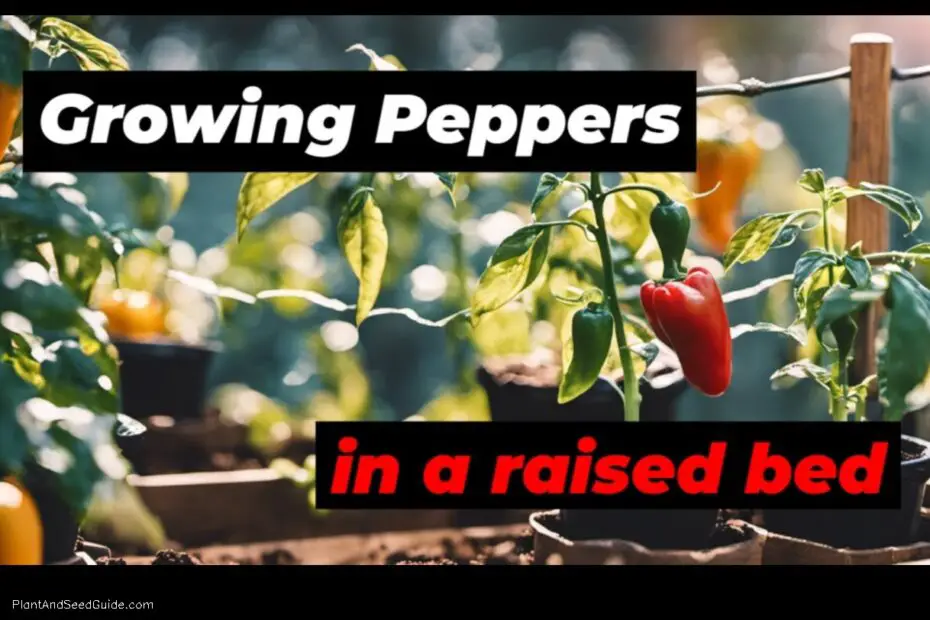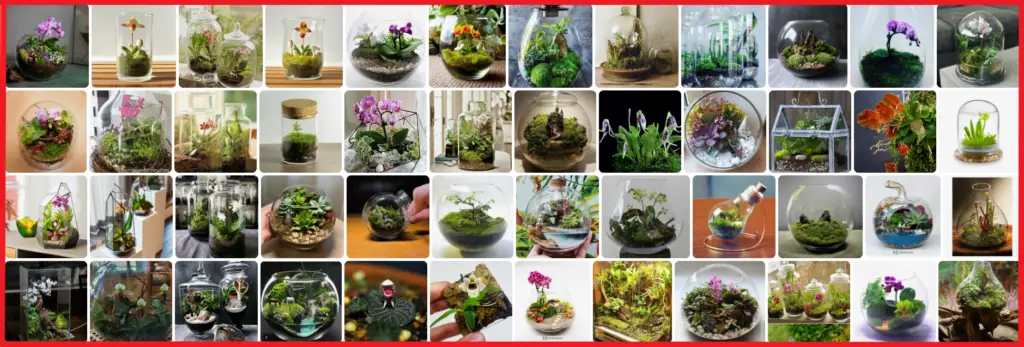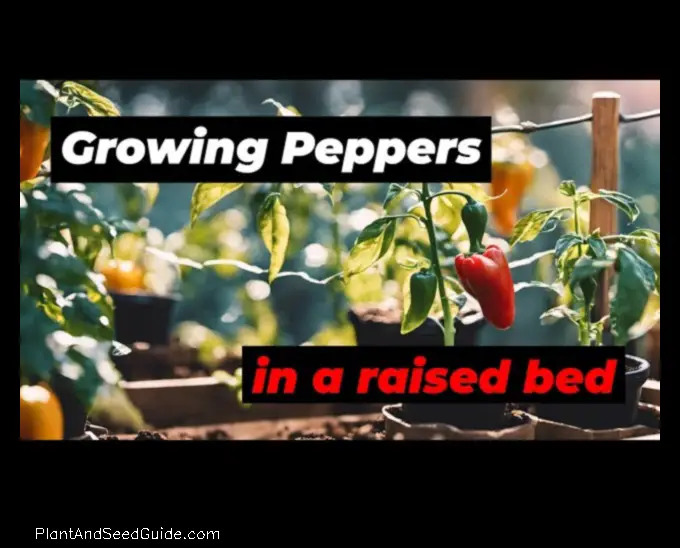

How to Plant Peppers in a Raised Bed
How to Plant Peppers in a Raised Bed
Peppers are a delicious and versatile vegetable that can be grown in a variety of climates. Raised beds are a great way to grow peppers, as they provide the perfect growing conditions for these plants.
In this article, we will discuss how to plant peppers in a raised bed. We will cover everything from choosing the right raised bed to harvesting your peppers.
Choosing the Right Raised Bed
The first step in planting peppers in a raised bed is to choose the right raised bed. The size of the raised bed will depend on the number of peppers you plan to grow.
For a small garden, a 4-foot by 4-foot raised bed is a good option. For a larger garden, you can choose a larger raised bed.
Loading... Seconds Left for
Miniature Orchid Terrarium Gallery!

The material of the raised bed is also important. Wood, plastic, and concrete are all popular choices for raised beds. Wood is a natural material that is easy to work with, but it can rot over time. Plastic raised beds are durable and long-lasting, but they can be more expensive than wood raised beds. Concrete raised beds are the most durable option, but they are also the most expensive.
Once you have chosen the right raised bed, you need to prepare the soil. The soil in a raised bed should be well-drained and fertile. You can add compost or manure to the soil to improve drainage and fertility.
Planting Peppers in the Raised Bed
The best time to plant peppers in a raised bed is in the spring, after the last frost. Peppers can be started from seed or seedlings.
If you are
starting from seed, you will need to sow the seeds in a seed tray or pot. The seeds will germinate in about 2-3 weeks. Once the seedlings have developed 2-3 sets of true leaves, you can transplant them into the raised bed.
If you are using seedlings, you can plant them directly into the raised bed. Space the seedlings about 18 inches apart.
When planting peppers, it is important to bury the seedlings up to their first set of true leaves. This will help to prevent the seedlings from being blown over by the wind.
Peppers are relatively easy to care for, but there are a few things you need to do to ensure that they grow healthy and produce a bountiful harvest.
Peppers need full sun to thrive. They also need regular watering, especially during dry spells. You should water your peppers deeply, but avoid overwatering them.
Peppers also need fertilizer to grow healthy and produce a good harvest. You can use a balanced fertilizer, such as a 10-10-10 fertilizer, or a fertilizer specifically formulated for peppers.
Peppers are
susceptible to a variety of pests and diseases. The most common pests that attack peppers include aphids, mites, and whiteflies. The most common diseases that affect peppers include powdery mildew, rust, and bacterial spot.
To prevent pests and diseases from damaging your peppers, you can take a few steps. First, you can plant your peppers in a location that is not prone to pests and diseases. Second, you can practice good garden sanitation. This means removing weeds and debris from your garden and rotating your crops. Third, you can use insecticidal soaps or horticultural oils to control pests. Finally, you can use fungicides to control diseases.
Harvesting Peppers from the Raised Bed
Peppers are ready to harvest when they are firm and bright in color. The best time to harvest peppers is in the morning, when the peppers are cool and fresh.
To harvest
peppers, simply cut them off the stem with a sharp knife. You can harvest peppers as you need them, or you can harvest them all at once and store them for later use.
Peppers can be stored for several weeks at room temperature. To store peppers, place them in a paper bag or plastic bag and store them
| Feature |
Description |
| Raised bed gardening |
A gardening method that involves growing plants in raised beds. |
| Peppers |
A type of vegetable that is grown for its edible fruits. |
| Growing peppers |
The process of growing peppers from seed to harvest. |
| Gardening |
The practice of growing plants for food or pleasure. |
| Vegetable gardening |
The practice of growing vegetables for food. |

IChoosing_the_Right_Raised_Bed">IChoosing the Right Raised Bed
When choosing a raised bed for growing peppers, there are a few factors to consider:
- Size: The size of the raised bed will depend on the number of peppers you plan to grow. A good rule of thumb is to allow 2 square feet of space per plant.
- Material: Raised beds can be made from a variety of materials, including wood, plastic, and concrete. Wood is a popular choice because it is relatively inexpensive and easy to work with. However, it is important to use treated wood to prevent the growth of pests and diseases. Plastic and concrete raised beds are also durable options, but they can be more expensive than wood.
- Drainage: Raised beds need to have good drainage to prevent the roots of your peppers from rotting. Make sure the raised bed has at least 2 inches of drainage material at the bottom, such as gravel or crushed rock.
Planting Peppers in the Raised Bed
Once you have prepared your raised bed, it is time to plant your peppers. Peppers can be started from seed or purchased as seedlings. If you are starting from seed, you will need to sow the seeds about 6 weeks before the last frost date in your area. Peppers can be planted in the ground once the soil has warmed up to at least 65 degrees Fahrenheit.
When planting peppers, it is important to space them about 18 inches apart. Peppers are heavy feeders, so it is important to make sure that the soil is rich in nutrients. You can amend the soil with compost or manure before planting.
Peppers nee
d full sun to produce
fruit. If you live in an area with hot summers, it is important to provide some afternoon shade for your peppers.
Water your peppers regularly, especially during dry spells. Peppers are susceptible to drought stress, which can cause the fruit to drop.
Fertilize your peppers regularly with a balanced fertilizer. Peppers need a lot of nutrients to produce fruit, so it is important to fertilize them every 2-3 weeks.
Peppers are
susceptible to a number of pests and diseases. The most common pests include aphids, whiteflies, and mites. The most common diseases include powdery mildew, verticillium wilt, and bacterial spot.
To prevent pests and diseases, it is important to practice good garden sanitation. This includes removing weeds, dead leaves, and other debris from the garden. It is also important to rotate your crops and to avoid planting peppers in the same spot year after year.
If you do experience pests or diseases, there are a number of organic and chemical treatments available.
ng-peppers-in-the-raised-bed">Planting Peppers in the Raised Bed
To plant peppers in a raised bed, you will need the following materials:
- Peppers seedlings
- Soil mix
- Fertilizer
- Watering can
- Labels
Once
you have gathered your materials, you can begin planting your peppers.
1. Dig a hole in the raised bed that is twice the width and depth of the pepper seedling’s root ball.
2. Fill the hole with soil mix.
3. Gently r
emove the pepper seedling from its pot and place it in the hole.
4. Backfill the hole with soil mix and firm it down around the seedling.
5. Water the seedling thoroughly.
6. Label th
e seedling with its variety name.
You can also add a layer of mulch around the seedling to help retain moisture and protect the roots from the sun.
Peppers should be spaced 18-24 inches apart.
![]()
ing="async" src="https://plantandseedguide.com/wp-content/uploads/2024/01/How-to-Grow-Peppers-in-a-Raised-Bed-A-Step-by-Step-Guide-2.jpeg" alt="how to plant peppers in a raised bed" style="width:600px;height:400px;">
Caring for Peppers in the Raised Bed
Once your peppers have been planted, there are a few things you can do to help them grow and thrive.
Watering
Peppers nee
d regular watering, especially during hot and dry weather. Water your peppers deeply, so that the water reaches the roots. Allow the soil to dry out slightly between waterings.
Fertilizing
Peppers need a steady supply of nutrients to grow and produce peppers. Fertilize your peppers every 2-4 weeks with a balanced fertilizer, such as a 10-10-10 fertilizer.



